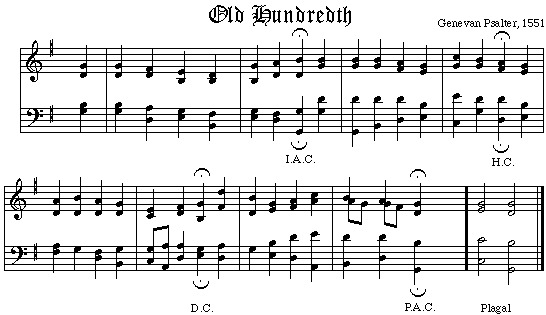Common Cadences
A cadence is just a fancy word for the last couple of chords in a phrase or song. When you're writing songs or progressions, you might want to use these to get a particular ending. Or maybe you already have used them "naturally" because they're in so many kinds of music and we're used to hearing them.
The Authentic Cadence
V I or V7 I
This one is by FAR the most common in almost every genre of music. Since we've heard it so much, it sounds very normal to our ears. The V chord has a very strong "pull" to I, our "home" chord. Putting a dominant seventh on the V chord is an even stronger pull.
The following example is in the key of C and starts with I vi to establish our key. The entire thing goes I vi ii V I.
Authentic Cadence
The Half Cadence
(any chord here) V
This is a common cadence in the middle of a progression. It creates a feeling of being unfinished - sort of "we're only half done" - because we're ending on the V chord, not I.
In a minor key, it's also worth noting the Phrygian Half cadence, which goes iv V.
This example goes I IV vi I V
Half Cadence
The Plagal Cadence
This cadence ends with I, our "home" chord, so it does have a sense of finality or resolution just like the authentic cadence. The IV in front of it has less of a pull than the stronger V I.
This cadence is also called the "amen" cadence because it's a very common tag at the end of hymns. AAAAAAAAAAAAAAAAHHH MENNNNN like that. If you know what I'm talking about it's a good way to remember what this cadence sounds like.
One rock tune that has this cadence is "Big Me" by the Foo Fighters. I'm sure there's many, many more.
This example goes I vi V IV I
Plagal Cadence
The Deceptive Cadence
V (insert anything else besides I)
Since the authentic cadence is SO prevalent, when you do something different, it actually sounds striking. Usually this is the vi chord, but can be anything. Since your ear expects that I "home" chord, and you don't get it, it sounds deceptive.
The following example goes I vi ii V vi
Deceptive Cadence
Classical Example
I found this example of a 1551 composition that uses ALL of the above types of cadence! Remember that cadences are only found at the end of a piece or phrase as a "finisher". Not every single V I chord is an authenic cadence.
Note the two authentic cadences, half cadence, deceptive, and plagal cadences! Don't worry about the I.A.C. and P.A.C., they're both authentic cadences.
